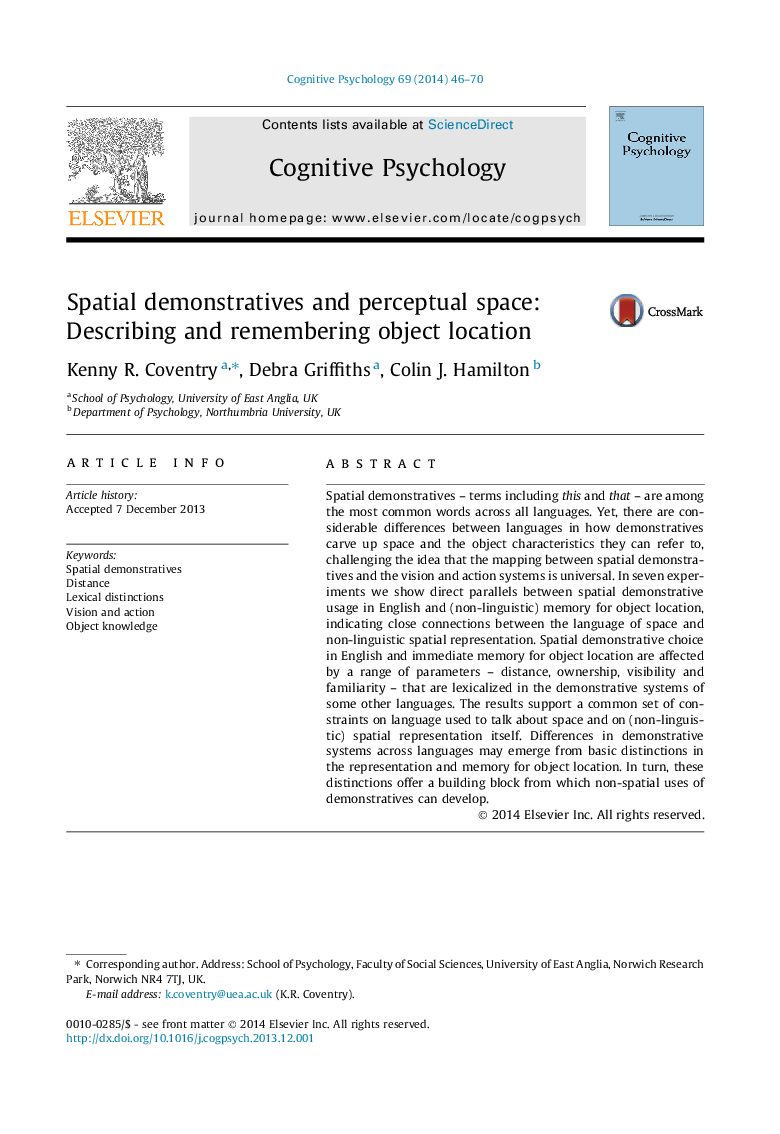| کد مقاله | کد نشریه | سال انتشار | مقاله انگلیسی | نسخه تمام متن |
|---|---|---|---|---|
| 7272831 | 1473395 | 2014 | 25 صفحه PDF | دانلود رایگان |
عنوان انگلیسی مقاله ISI
Spatial demonstratives and perceptual space: Describing and remembering object location
ترجمه فارسی عنوان
تظاهرات فضایی و فضای ادراکی: توصیف و به یاد آوردن مکان شیء
دانلود مقاله + سفارش ترجمه
دانلود مقاله ISI انگلیسی
رایگان برای ایرانیان
کلمات کلیدی
ترجمه چکیده
تظاهرات فضایی - شرایطی از جمله این و آن - یکی از رایج ترین واژه ها در همه زبان ها است. با این حال، تفاوت های قابل توجهی بین زبان ها در چگونگی ترسیم فضاها و ویژگی های شئ آنها وجود دارد که می توان آنها را بیان کرد، به چالش کشیدن این ایده که نقشه برداری بین تظاهرات فضایی و سیستم های دید و سیستم عامل جهانی است. در هفت آزمایش، ما نشان می دهد که همبستگی مستقیم بین استفاده مدرن فضایی در زبان انگلیسی و حافظه (غیر زبان شناختی) برای مکان جسم، نشان دهنده ارتباط نزدیک بین زبان فضایی و نمایندگی فضایی غیر زبان شناختی است. انتخاب تظاهرات فضایی در زبان انگلیسی و حافظه فوری برای موقعیت جسم از طریق طیف وسیعی از پارامترها - فاصله، مالکیت، دید و آشنایی - تحت تاثیر قرار می گیرند که در سیستم های نشان دهنده برخی از زبان های دیگر مورد استفاده قرار می گیرند. نتایج حاصل از مجموعه محدودی از محدودیت ها در مورد زبان مورد استفاده برای صحبت در مورد فضا و (خودمختاری) غیرمجاز فضایی پشتیبانی می کند. تفاوت در سیستم های تظاهرات در سراسر زبان ممکن است از تفاوت های اساسی در نمایندگی و حافظه برای مکان شیء ظاهر شود. به نوبه خود، این تمایز ها یک بلوک ساختمانی ارائه می دهند که از آن استفاده های غیر فضایی تظاهرات می تواند توسعه یابد.
موضوعات مرتبط
علوم زیستی و بیوفناوری
علم عصب شناسی
علوم اعصاب شناختی
چکیده انگلیسی
Spatial demonstratives - terms including this and that - are among the most common words across all languages. Yet, there are considerable differences between languages in how demonstratives carve up space and the object characteristics they can refer to, challenging the idea that the mapping between spatial demonstratives and the vision and action systems is universal. In seven experiments we show direct parallels between spatial demonstrative usage in English and (non-linguistic) memory for object location, indicating close connections between the language of space and non-linguistic spatial representation. Spatial demonstrative choice in English and immediate memory for object location are affected by a range of parameters - distance, ownership, visibility and familiarity - that are lexicalized in the demonstrative systems of some other languages. The results support a common set of constraints on language used to talk about space and on (non-linguistic) spatial representation itself. Differences in demonstrative systems across languages may emerge from basic distinctions in the representation and memory for object location. In turn, these distinctions offer a building block from which non-spatial uses of demonstratives can develop.
ناشر
Database: Elsevier - ScienceDirect (ساینس دایرکت)
Journal: Cognitive Psychology - Volume 69, March 2014, Pages 46-70
Journal: Cognitive Psychology - Volume 69, March 2014, Pages 46-70
نویسندگان
Kenny R. Coventry, Debra Griffiths, Colin J. Hamilton,
